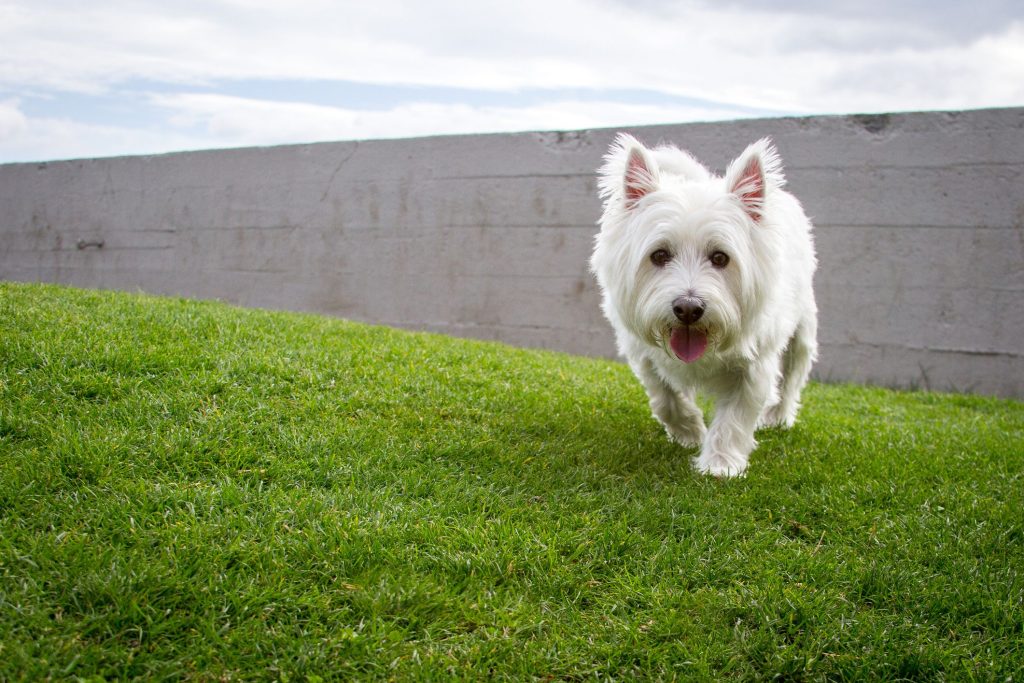
Ah, the West Highland White Terrier – a breed so adorable, so fluffy, and yet so utterly fearless that you’ll often find yourself wondering if you accidentally adopted a miniature lion instead of a dog. With their distinctive white coats and those big, expressive eyes, these pups are undeniably cute. But make no mistake, dear friends, owning a Westie is no walk in the park (unless you consider fending off squirrels and digging up your flowerbeds a leisurely stroll).
These little guys were bred to hunt badgers and foxes, which means they possess an unparalleled level of tenacity, stubbornness, and an unwavering belief that they are, in fact, the rulers of the household. Buckle up, because we’re about to dive headfirst into the wild world of Westie ownership!

The Westie 101: A Wee History Lesson
Before we get into the nitty-gritty of caring for these tiny terrors, let’s take a quick trip through history. The West Highland White Terrier hails from (you guessed it) the western highlands of Scotland, where they were prized for their skills as fearless hunters and their ability to navigate the rugged terrain.
Fast forward to the present day, and Westies have traded in their hunting prowess for a life of couch-surfing, squirrel-chasing, and generally keeping their owners on their toes. But don’t let their diminutive stature fool you – these pups still possess that fierce hunting instinct, which means they require plenty of exercise, mental stimulation, and a whole lot of patience to keep them from turning your living room into a war zone.
Exercise and Mental Stimulation: Keeping the Westie Busy
Imagine a tiny ball of energy fueled by pure determination and an unwavering desire to chase anything that moves, and you’ve pretty much summed up a Westie’s exercise requirements. These dogs may be small, but they have the stamina and endurance of a marathon runner (or, more accurately, a furry little drill sergeant).
Here are a few tried-and-true methods for keeping your Westie happy, healthy, and (somewhat) out of trouble:
- Walk, Run, Repeat: Westies thrive on regular walks or jogs, where they can burn off that excess energy and satisfy their insatiable curiosity. Just be prepared for them to set a brisk pace that’ll leave you huffing and puffing behind them.
- Fetch, But Make It Interesting: A simple game of fetch is never just a simple game of fetch with a Westie. These dogs will turn it into an Olympic sport, complete with acrobatic leaps, sudden changes of direction, and a level of intensity that would put most professional athletes to shame.
- Agility Training: If you really want to unleash your Westie’s inner athlete, consider enrolling them in agility classes. These fast-paced obstacle courses are the perfect outlet for their boundless energy and incredible agility.
- Puzzle Toys: When you’re not up for a full-blown cardio session, puzzle toys and interactive feeders can provide much-needed mental stimulation for your Westie’s sharp mind.
Grooming and Shedding: Embracing the Fluff
Let’s be real – owning a Westie means committing to a lifetime of dealing with their glorious, white fur. These dogs shed like it’s their job, and their thick, double coats offer little reprieve from the constant shedding onslaught.
But fear not, my friends! With a bit of diligence and the right tools, you can stay on top of the fur situation (mostly). Here’s what you’ll need in your grooming arsenal:
- A good quality slicker brush or deshedding tool
- A vacuum cleaner with industrial-strength suction (trust me, you’ll need it)
- Lint rollers (so many lint rollers)
- A sense of humor (because you’ll be finding Westie hair in places you never thought possible)
Regular brushing is key to controlling the shedding, so make it a part of your weekly routine. And when it comes to bathing, stick to a mild, hypoallergenic shampoo to keep that brilliant white coat looking its best.
Training and Socialization: Taming the Tiny Terrier
Westies are incredibly intelligent, which is both a blessing and a curse. On the one hand, they’re quick learners and can master complex commands and tricks with relative ease. On the other hand, their sharp minds and stubborn streaks can lead to some truly creative (read: destructive) behavior if left to their own devices.
That’s why proper training and socialization are crucial from an early age. Enroll your Westie in puppy classes as soon as possible, where they can learn basic obedience commands and proper canine etiquette. Positive reinforcement training methods work best for these sensitive souls, as they respond poorly to harsh corrections or punishment.
And don’t forget about socialization! Westies can be a bit standoffish with strangers and other dogs if they’re not properly socialized, so expose them to new sights, sounds, and experiences in a controlled and positive way. Trust me, the last thing you want is a 15-pound Westie throwing a tantrum in the middle of the dog park.

Conclusion: Embracing the Chaos (and the Love)
Owning a West Highland White Terrier is a rollercoaster ride filled with equal parts love, laughter, and the occasional desire to pull your hair out (which, let’s be honest, your Westie has probably already done for you). These dogs are high-energy, mischievous, and utterly devoted to their owners – a combination that can be both exhilarating and exhausting.
But for those willing to put in the time, effort, and endless supply of lint rollers, the rewards of Westie ownership are truly unmatched. These dogs are loyal companions, fearless adventure buddies, and a constant source of entertainment (whether intentional or not).
So, embrace the chaos, my friends! Stock up on puzzle toys, invest in a heavy-duty vacuum, and get ready for a lifetime of unconditional love and laughter with your very own tiny terror.
FAQs
- Are West Highland White Terriers good with children? Westies can make excellent family dogs, as they’re generally very affectionate and loyal. However, their high energy levels and tendency to be territorial can pose a risk around small children, so it’s important to supervise interactions and teach kids how to properly interact with dogs.
- Do West Highland White Terriers bark a lot? While Westies aren’t known as excessive barkers, they can be vocal dogs, especially when they’re bored or seeking attention. Proper exercise, training, and mental stimulation can help curb excessive barking.
- Are West Highland White Terriers easy to train? Westies are highly intelligent dogs, which can make them quick learners when it comes to training. However, their stubborn streak and strong-willed nature can also make them challenging to train, especially for first-time dog owners. Consistency and positive reinforcement are key.
- Can West Highland White Terriers be left alone for long periods? Due to their high energy levels and potential for separation anxiety, Westies generally shouldn’t be left alone for extended periods. They do best with owners who can provide ample exercise, mental stimulation, and companionship throughout the day.
- Are West Highland White Terriers good apartment dogs? While Westies can adapt to apartment living with proper exercise and training, their high energy levels and potential for barking may make them better suited for a home with a yard or easy access to parks and hiking trails.






